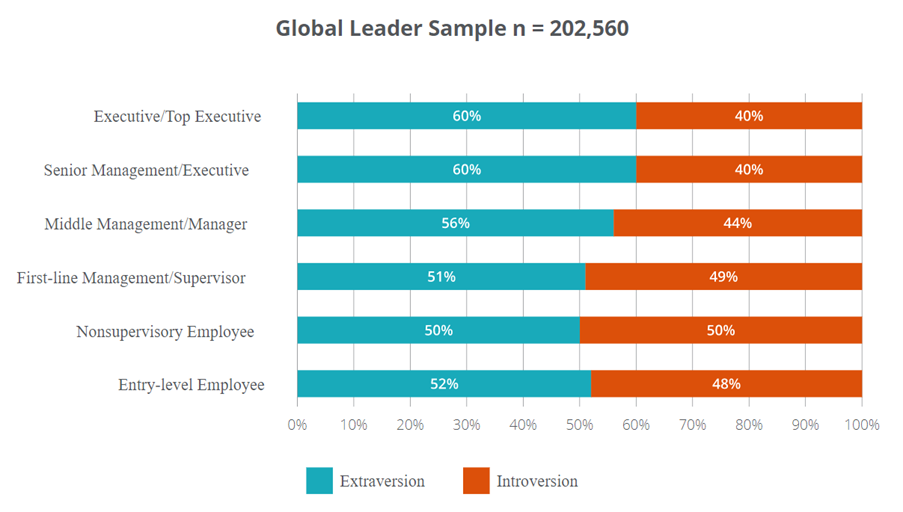Video Games, Executives, Brainstorming and Introversion
The Myers-Briggs Company Shares Six Lesser Known Facts for World Introvert Day
Sunnyvale, Calif., January 2, 2019 -- Following the fireworks, parties and enthusiastic countdowns, World Introvert Day (January 2) celebrates those who get their energy from their inner world of thoughts and feelings and quiet reflection rather than by being around large groups.
Although half of the world’s population prefers Introversion, it’s only been in the last few decades that this group has received their share of the spotlight.
“People who prefer Introversion have specific ways they experience and contribute to the world. Our recent global well-being research found Introverts prefer activities such as reading, learning something new at work or spending time (both in and outside of work) with people they’re close to,” says Martin Boult, psychologist and Sr. Director of Professional Services and International Training for The Myers-Briggs Company’s Australian office. “These activities allow them time to reflect or explore important issues in-depth, which supports their overall well-being. Our research also suggests that organizations encouraging or rewarding more extraverted behaviors may not always appreciate what helps Introverts enhance their well-being and performance at work.”
In honor of those who prefer Introversion, The Myers-Briggs Company shares six surprising statistics (video) you may not know about these reflective types:
1. Around the world, many more senior managers and executives prefer Extraversion than Introversion
Although the world’s population is split down the middle in terms of those who prefer Extraversion and Introversion, a global sample of over 200,000 employees shows that only 40% of the executives, top executives, and senior managers prefer Introversion. These numbers vary by country with some countries having a significantly lower share of introverted senior leaders than others. For example, 40% of executives in the United States and 38% of executives in India prefer Introversion, while 32% of executives in Mexico and 30% of executives in the UK prefer Introversion.

2. Those preferring Introversion brainstorm differently
Brainstorming is virtually mandatory in the world of work today. But how employees approach and contribute to brainstorming sessions depends on whether they have a preference for Introversion or Extraversion. When Introverts speak up in brainstorming sessions, it’s usually after they’ve evaluated and eliminated options on their own. They share the final product of their individual mental brainstorming. Compare that to Extraverts, who usually speak ideas as they come to mind and are often more comfortable talking over one another.
Organizations generally model brainstorming sessions with the extraverted process in mind. The downside of this is people incorrectly concluding Introverts aren’t as engaged in brainstorming sessions as Extraverts.
Tip: To ensure your brainstorming is truly utilizing all the brains in the room, send out the topic or prompt ahead of time. That way, those who prefer Introversion have time to do their own brainstorming before the meeting. This allows Introverts to bring their ideas to the table without competing to have their ideas heard.
3. The strongest part of an Introvert’s personality isn’t what you see
People are far more complex than simply Introverts and Extraverts. In fact, Introversion and Extraversion are more verbs than nouns. Every person extraverts some part of their personality (outwardly displaying it) and also introverts another part of their personality (using that personality process internally and not outwardly displaying it). According to personality type dynamics theory (how parts of personality type work together), the most developed part of an Introvert’s personality is introverted. The part of an Introvert’s personality that’s extraverted is a less developed part of their personality. Essentially, an Introvert’s personality superpower isn’t what’s seen by others.
4. Even if you prefer Extraversion, you’ll introvert some of your personality
If you have a preference for Extraversion, the most developed part of your personality is extraverted (outwardly shown). However, that also means that your second-favorite process (call it your minor personality superpower) is introverted. Whether a person has preferences for ESTJ or ENFP, there’s a part of their personality that’s actually introverted (which is good news since it means everyone can celebrate World Introvert Day!)
5. Those preferring Introversion score lower in workplace well-being surveys than those who prefer Extraversion
Results from The Myers-Briggs Company’s three-year study titled Well-being and MBTI Personality Type in the Workplace: An International Comparison show a statistically significant difference between those preferring Introversion and those preferring Extraversion when it comes to workplace well-being. Four-letter type aside, those who prefer Introversion score an average of 1 point lower on a 10-point scale, or roughly 10% lower in overall well-being than those who prefer Extraversion.
Tip: Workplaces have the opportunity to find more ways to support their introverted employee’s well-being. Why is it important? Higher levels of well-being not only benefit the individual but also improve performance of organizations. The results from the study show most Introverts report the following activities to be effective for supporting their well-being at work:
- Undertaking work where they learn something new
- Undertaking work that gives them a sense of purpose
- Helping co-workers when they need assistance
6. If you prefer ISTP, playing video games may increase your wellbeing
The well-being research also highlights that Introverted types are more selective than Extraverted types when it comes to the number and type of activities they use outside of work to support their well-being.
Introverted types are more likely to select intrapersonally-oriented activities (e.g. reading, playing video games, meditation, adjusting expectations) to support their well-being. For example, the activity ISTP types rated as the most effective for increasing their well-being was ‘playing video games.’ It makes sense, as playing video games relates to motivational aspects of the ISTP personality type (goal oriented, preferring an introverted environment). A summary of what each personality type found effective or less effective is detailed in The Myers-Briggs Company’s research white paper: Well-being in the Workplace: Why it Matters for Organizational Performance and How to Improve It (Boult, Thompson & Schaubhut, 2018).
Get In Touch
